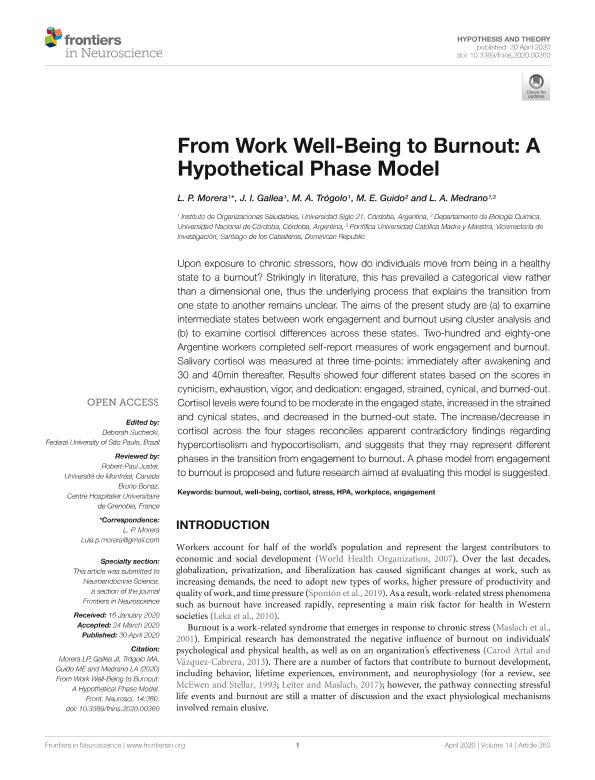Mostrar el registro sencillo del ítem
dc.contributor.author
Morera, Luis Pedro

dc.contributor.author
Gallea, Jose Ignacio

dc.contributor.author
Trógolo, Mario Alberto

dc.contributor.author
Guido, Mario Eduardo

dc.contributor.author
Medrano, L. A.
dc.date.available
2021-10-15T23:49:14Z
dc.date.issued
2020-04
dc.identifier.citation
Morera, Luis Pedro; Gallea, Jose Ignacio; Trógolo, Mario Alberto; Guido, Mario Eduardo; Medrano, L. A.; From Work Well-Being to Burnout: A Hypothetical Phase Model; Frontiers Media; Frontiers in Neuroscience; 14; 4-2020; 1-9
dc.identifier.uri
http://hdl.handle.net/11336/143963
dc.description.abstract
Upon exposure to chronic stressors, how do individuals move from being in a healthy state to a burnout? Strikingly in literature, this has prevailed a categorical view rather than a dimensional one, thus the underlying process that explains the transition from one state to another remains unclear. The aims of the present study are (a) to examine intermediate states between work engagement and burnout using cluster analysis and (b) to examine cortisol differences across these states. Two-hundred and eighty-one Argentine workers completed self-report measures of work engagement and burnout. Salivary cortisol was measured at three time-points: immediately after awakening and 30 and 40min thereafter. Results showed four different states based on the scores in cynicism, exhaustion, vigor, and dedication: engaged, strained, cynical, and burned-out. Cortisol levels were found to be moderate in the engaged state, increased in the strained and cynical states, and decreased in the burned-out state. The increase/decrease in cortisol across the four stages reconciles apparent contradictory findings regarding hypercortisolism and hypocortisolism, and suggests that they may represent different phases in the transition from engagement to burnout. A phase model from engagement to burnout is proposed and future research aimed at evaluating this model is suggested.
dc.format
application/pdf
dc.language.iso
eng
dc.publisher
Frontiers Media

dc.rights
info:eu-repo/semantics/openAccess
dc.rights.uri
https://creativecommons.org/licenses/by/2.5/ar/
dc.subject
BURNOUT
dc.subject
CORTISOL
dc.subject
ENGAGEMENT
dc.subject
HPA
dc.subject
STRESS
dc.subject
WELL-BEING
dc.subject
WORKPLACE
dc.subject.classification
Bioquímica y Biología Molecular

dc.subject.classification
Ciencias Biológicas

dc.subject.classification
CIENCIAS NATURALES Y EXACTAS

dc.title
From Work Well-Being to Burnout: A Hypothetical Phase Model
dc.type
info:eu-repo/semantics/article
dc.type
info:ar-repo/semantics/artículo
dc.type
info:eu-repo/semantics/publishedVersion
dc.date.updated
2021-09-06T15:05:13Z
dc.identifier.eissn
1662-453X
dc.journal.volume
14
dc.journal.pagination
1-9
dc.journal.pais
Suiza

dc.journal.ciudad
Lausana
dc.description.fil
Fil: Morera, Luis Pedro. Consejo Nacional de Investigaciones Científicas y Técnicas; Argentina. Universidad Siglo 21; Argentina
dc.description.fil
Fil: Gallea, Jose Ignacio. Consejo Nacional de Investigaciones Científicas y Técnicas; Argentina. Universidad Siglo 21; Argentina
dc.description.fil
Fil: Trógolo, Mario Alberto. Consejo Nacional de Investigaciones Científicas y Técnicas; Argentina. Universidad Siglo 21; Argentina
dc.description.fil
Fil: Guido, Mario Eduardo. Consejo Nacional de Investigaciones Científicas y Técnicas. Centro Científico Tecnológico Conicet - Córdoba. Centro de Investigaciones en Química Biológica de Córdoba. Universidad Nacional de Córdoba. Facultad de Ciencias Químicas. Centro de Investigaciones en Química Biológica de Córdoba; Argentina
dc.description.fil
Fil: Medrano, L. A.. Consejo Nacional de Investigaciones Científicas y Técnicas; Argentina. Universidad Siglo 21; Argentina
dc.journal.title
Frontiers in Neuroscience
dc.relation.alternativeid
info:eu-repo/semantics/altIdentifier/url/https://www.frontiersin.org/article/10.3389/fnins.2020.00360/full
dc.relation.alternativeid
info:eu-repo/semantics/altIdentifier/doi/http://dx.doi.org/10.3389/fnins.2020.00360
Archivos asociados
